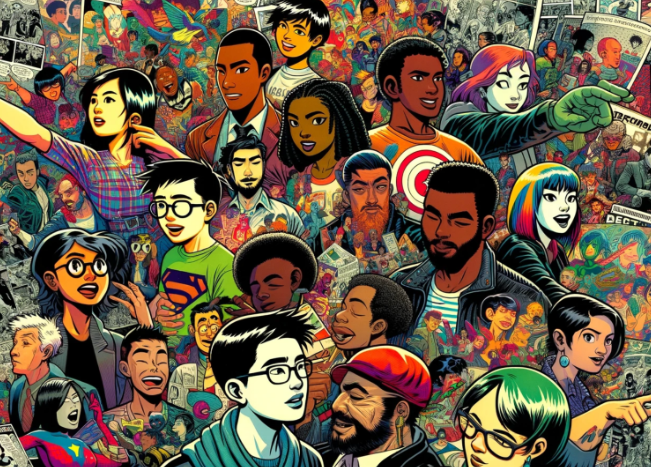The Rise of Indie Comics
The rise of indie comics marks a significant shift in the comic book industry, reflecting broader cultural, technological, and economic changes. This phenomenon is characterized by an increasing number of creators and small publishers producing work outside the mainstream comic book publishing houses, such as Marvel and DC Comics. Indie comics offer a diverse range of genres, styles, and narratives, often exploring themes and subjects not typically covered by their mainstream counterparts. This movement has been facilitated by several key factors:
Digital Revolution and Social Media
The advent of digital publishing platforms and social media has drastically lowered the barriers to entry for comic book creators. Websites, digital comics platforms, and crowdfunding sources like Kickstarter have provided indie creators with the tools to publish, promote, and distribute their work directly to audiences worldwide. Social media platforms enable creators to build and engage with their communities, garnering support and feedback directly from their audience.
Creative Freedom
One of the most appealing aspects of indie comics is the creative freedom they offer to creators. Without the constraints of fitting into the established universes of big publishers or adhering to their editorial policies, indie creators can explore a wide range of themes, storytelling techniques, and art styles. This freedom has led to the production of highly innovative, experimental, and personal works that push the boundaries of the medium.
Diverse Voices and Representation
Indie comics have been at the forefront of promoting diversity and representation within the comic book industry. They provide a platform for voices that have historically been marginalized, including creators of different ethnicities, genders, sexual orientations, and cultural backgrounds. This diversity is reflected in the stories told, the characters featured, and the issues explored, making comics more accessible and relevant to a wider audience.
Festivals, Conventions, and Direct Market
The rise of comic book festivals and conventions has played a crucial role in the growth of the indie comic scene. These events offer creators opportunities to showcase their work, network with other professionals, and sell their comics directly to fans. Additionally, the direct market—specialty comic book shops—has been instrumental in supporting indie publishers and self-published creators by providing them with a physical space to reach readers.
Impact on the Industry
The success of indie comics has not only expanded the market but also influenced mainstream publishers. The innovation and diversity seen in indie comics have pushed larger publishers to broaden their own offerings and to incorporate more diverse voices and creative risks into their portfolios.
Challenges
Despite their growth and success, indie comics face challenges, including financial sustainability, market visibility, and distribution. However, the passion of indie comic creators and their communities continues to drive the industry forward, ensuring that indie comics remain a vibrant and essential part of the comic book world.
The rise of indie comics is a testament to the evolving landscape of storytelling, where creators are empowered to share their unique visions and stories with a global audience. As technology and society continue to evolve, indie comics will undoubtedly play a crucial role in shaping the future of the comic book industry.
The History and Evolution of Indie Comics
The history and evolution of indie comics is a fascinating journey that reflects broader societal, cultural, and technological shifts. Indie comics, also known as independent comics, distinguish themselves from mainstream comics by their diversity in themes, artistic freedom, and often their method of publication. Unlike the superhero-centric narratives commonly associated with giants like Marvel and DC Comics, indie comics span a vast array of genres, styles, and storytelling techniques. This diversity allows for a more personalized and experimental approach to comic book creation.
Origins and Early Days
The roots of indie comics can be traced back to the underground comix movement of the 1960s and 1970s. These comics were marked by their departure from the mainstream, featuring content that was often countercultural, politically charged, and adult-oriented. Creators like Robert Crumb and Art Spiegelman were pivotal in pushing the boundaries of the medium, exploring themes that were considered taboo by mainstream standards. These underground comix were typically self-published or distributed through small, independent publishers and sold in alternative venues outside the traditional comic book market.
The 1980s and the Direct Market
The 1980s saw significant developments in the comic book industry that favored the rise of indie comics. The establishment of the direct market, which allowed comic book stores to order comics directly from publishers, provided a lifeline for indie publishers. This system bypassed the traditional newsstand distribution, offering a more sustainable model for selling niche and independent titles. During this era, publishers like Fantagraphics Books, First Comics, and later Image Comics, began to emerge, providing platforms for creators to publish work that differed from the mainstream superhero genre.
The 1990s and the Creator-Owned Movement
The 1990s witnessed the rise of the creator-owned movement, spearheaded by the founding of Image Comics in 1992. This movement was characterized by creators retaining the rights to their work, as opposed to the work-for-hire model dominant in mainstream comics. Image Comics’ foundation by high-profile artists and writers from Marvel and DC was a significant turning point, signaling that commercially viable and critically acclaimed work could exist outside the traditional superhero genre. This period also saw the growth of other indie publishers like Dark Horse Comics, which further diversified the types of stories being told.
Digital Age and Crowdfunding
The advent of the internet and digital publishing in the 21st century marked the next significant phase in the evolution of indie comics. Digital platforms allowed creators to reach a global audience without the need for physical distribution. Webcomics and digital comics became popular, enabling creators to publish their work online with greater ease. Moreover, crowdfunding platforms like Kickstarter and Indiegogo revolutionized the funding model for indie comics, allowing creators to finance their projects through direct support from readers.
Today’s Landscape
Today, the indie comic scene is more vibrant and diverse than ever. Digital technology, social media, and crowdfunding continue to lower barriers to entry, enabling a new generation of creators to tell stories that are personal, experimental, and diverse. Indie comics festivals and conventions have also grown in popularity, providing vital platforms for creators to showcase their work and connect with audiences. The indie scene is now a crucial part of the comic book industry, pushing the medium in new directions and ensuring that comics remain a dynamic and evolving form of storytelling.
The evolution of indie comics is a testament to the creativity, resilience, and innovation of comic book creators. It reflects a continual desire to explore new narratives, art forms, and publishing models, ensuring that the comic book medium remains relevant and engaging in the changing cultural landscape.
Marketing Strategies for Indie Comics
Marketing indie comics requires creativity, persistence, and a deep understanding of both the product and the target audience. Unlike mainstream comics, which often benefit from the backing of large publishers with significant marketing budgets, indie comics rely on more grassroots strategies. Here are several effective marketing strategies tailored for indie comics:
1. Leverage Social Media and Online Platforms
- Social Media Presence: Create and maintain active social media profiles on platforms where your target audience is most active, such as Instagram, Twitter, and Facebook. Use these platforms to share behind-the-scenes content, artwork teasers, and updates about your comic.
- Webcomics and Online Samples: Publish portions of your work online as webcomics or free samples. This can attract readers and generate interest in your full comic.
- YouTube and Podcasts: Consider creating video content or participating in podcasts related to comics to discuss your work and share your creative process.
2. Crowdfunding Campaigns
- Kickstarter or Indiegogo: Use crowdfunding platforms to not only raise funds for your project but also to build a community around your comic. Offer exclusive rewards and updates to backers to keep them engaged.
3. Engage with the Community
- Comic Conventions and Indie Comic Fests: Attend comic conventions, indie festivals, and local events to showcase your work. Physical presence allows for direct engagement with potential readers and builds personal connections.
- Networking: Connect with other creators, publishers, and influencers in the comic book industry. Collaborations and shoutouts can significantly increase your visibility.
4. Utilize Email Marketing
- Newsletter: Build an email list and send out regular newsletters to keep your audience informed about new releases, events, and exclusive content. Personalized emails can help maintain interest and loyalty among your readers.
5. Press and Reviews
- Press Releases: Send out press releases about your comic to comic book blogs, local media, and industry publications.
- Get Reviewed: Encourage reviews from comic book reviewers and influencers. Positive reviews can be powerful endorsements that attract new readers.
6. Online Advertising
- Targeted Ads: Use targeted advertising on social media platforms and Google to reach potential readers interested in similar genres or themes as your comic.
7. Collaborate with Retailers
- Local Comic Shops: Build relationships with local comic book shops to get your indie comic stocked and possibly featured in their store.
- Consignment Deals: Consider consignment deals with bookstores or specialty shops that cater to your target demographic.
8. Create a Strong Brand Identity
- Branding: Develop a strong, recognizable brand for your comic. This includes a compelling logo, consistent visual style, and tone across all your marketing materials.
9. Digital Platforms and Distribution
- Digital Distribution: Use platforms like ComiXology, Gumroad, or your own website to sell digital versions of your comic. Digital distribution can significantly expand your reach.
10. Engage in Content Marketing
- Blogging and Vlogging: Create content that adds value beyond just selling your comic. This could include tutorials, insights into the creative process, or discussions on themes relevant to your comic.

